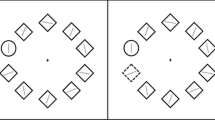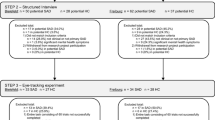Abstract
This study provides preliminary tests of two hypotheses: (1) Anxiety-disordered children show an attentional bias toward emotionally threatening stimuli, and (2) normal controls show an attentional bias away from emotionally threatening stimuli. Twelve children, 9 to 14 years of age, with primary diagnoses of anxiety disorder were compared with 12 normal controls matched for age, gender, vocabulary level, and reading ability. Subjects completed a reaction time task that measured visual attention toward threatening versus neutral words. The anxious group showed the predicted attentional bias toward threat words. However, controls did not show the predicted bias away from threat words. These results are the first showing that biased attentional processing occurs among clinically anxious children. The potential role of such an attentional bias in childhood anxiety disorders and future direction for research are discussed.
Similar content being viewed by others
References
Achenbach, T. M. (1991).Manual for the Child Behavior Checklist-/4-18 and 1991 Profile. Burlington: University of Vermont, Department of Psychiatry.
American Psychiatric Association (1987).Diagnostic and statistical manual of mental disorders (3rd ed., rev.). Washington, DC: Author.
Bush, L. K., Hess, U., & Wolford, G. (1993). Transformations for within-subject designs: A Monte Carlo investigation.Psychological Bulletin, 113, 566–579.
Cohen, J. (1960). A coefficient of agreement for nominal scales.Educational and Psychological Measures, 20, 37–46.
Dale, E., & O'Rourke, J. (1981).The living word vocabulary. Chicago: World Book-Childcraft International.
Dalgliesh, T., & Watts, F. N. (1990). Biases of attention and memory in disorders of anxiety and depression.Clinical Psychology Review, 10, 589–604.
Hollingshead, A. B. (1975).Four factor index of social status. Unpublished manuscript, Department of Sociology, Yale University, New Haven, CT.
Kendall, P. C., & Chansky, T. E. (1991). Considering cognition in anxiety-disordered children.Journal of Anxiety Disorders, 5, 167–185.
Kovacs, M. (1981). Rating scales to assess depression in school-aged children.Acta Paedopsychiatrica, 46, 305–315.
Logan, A. C., & Goetsch, V. L. (1993). Attention to external threat cues in anxiety states.Clinical Psychology Review, 13, 541–559.
MacLeod, C., & Mathews, A. (1988). Anxiety and allocation of attention to threat.The Quarterly Journal of Experimental Psychology, 40, 653–670.
MacLeod, C., Mathews, A., & Tata, P. (1986). Attentional bias in emotional disorders.Journal of Abnormal Psychology, 95, 15–20.
Martin, M., Horder, P., & Jones, G. V. (1992). Integral bias in naming phobia-related words.Cognition and Emotion, 6, 479–486.
Martin, M., Williams, R. M., & Clark, D. M. (1991). Does anxiety lead to selective processing of threat-related information?Behavior Research and Therapy, 29, 147–160.
Mathews, A., & Klug, F. (1993). Emotionality and interference with color-naming in anxiety.Behaviour Research and Therapy, 31, 57–62.
Mogg, K., Mathews, A., & Eysenck, M. (1992). Attentional bias to threat in clinical anxiety states.Cognition and Emotion, 6, 149–159.
Reynolds, C. R., & Richmond, B. O. (1985).Manual for the Revised Children's Manifest Anxiety Scale. Los Angeles: Western Psychological Services.
Silverman, W. K., Fleisig, W., Rabian, B., & Peterson, R. A. (1991). The childhood anxiety sensitivity index.Journal of Clinical Child Psychology, 20, 162–168.
Silverman, W. K., & Nelles, W. B. (1988). The Anxiety Disorders Interview Schedule for Children.Journal of the American Academy of Child and Adolescent Psychiatry, 27, 772–778.
Spielberger, C. D. (1973).Manual for the State-Trait Anxiety Inventory for children. Palo Alto, CA: Consulting Psychologists Press.
Stroop, J. R. (1935). Studies of interference in serial verbal reactions.Journal of Experimental Psychology, 18, 643–662.
Vasey, M. W. (1993). Development and cognition in childhood anxiety: The example of worry. In T. H. Ollendick & R. J. Prinz (Eds.),Advances in clinical child psychology (Vol. 15); (pp. 1–39). New York: Plenum Press.
Vasey, M. W., Elhag, N., & Daleiden, E. L. (1994).Anxiety and the processing of emotionally-threatening stimuli: Distinctive patterns of selective attention among high- and low-anxious children. Manuscript submitted for publication.
Wechsler, D. (1974).Manual for the Wechsler Intelligence Scale for Children—Revised. New York: The Psychological Corporation.
Woodcock, R. W. (1987).Woodcock Reading Mastery Tests—revised examiner's manual. Circle Pines, MN: American Guidance Service.
Author information
Authors and Affiliations
Rights and permissions
About this article
Cite this article
Vasey, M.W., Daleiden, E.L., Williams, L.L. et al. Biased attention in childhood Anxiety disorders: A preliminary study. J Abnorm Child Psychol 23, 267–279 (1995). https://doi.org/10.1007/BF01447092
Received:
Issue Date:
DOI: https://doi.org/10.1007/BF01447092




